My contribution, although inserted in the session, dealt however with a different topic. Indeed, by having participated two years earlier at the former event in the series, I knew that the risk of discussing containers instead of content was too high. People who do science popularization using tools such as virtual spaces (second life), blogs, interactive web applications and the like are often quite enamoured with these means, and if given a chance they will rather discuss how cool these are rather than what content makes their endeavour a successful one.
I do believe that in order for a science outreach project to work out it needs to provide good content, and unfortunately there is not enough training available for the good souls who understand that a part of their work should be to disseminate the knowledge they produce.
So let's discuss content. I did my little bit by taking on a topic I find very important: how to construct a good analogy to explain a difficult concept or system, or to make it more familiar to an audience of laypersons or anyway less-trained individuals.
In the end my talk was a half disaster by my own standards (maybe I am too hard to myself, but I did not like the performance anyway), because I had collected enough material to speak for one hour, and I had only managed with difficult choices to reduce it to a 25' talk -only to discover that the format of talks was of 15' plus 5' for questions. To make matters worse, I was scheduled as second-to-last in the afternoon, and the delays due the straggling of previous speakers' talks pushed my talk to 6.30PM - when we knew we had to leave the room by 7PM!
Furthermore, I had made a controversial choice in putting together my slides: since I know that in some instances slides are used independently of the talk, I decided to make them readable after the event. This has the obvious shortcoming that they become verbose and can distract the people in the audience at the conference. I was criticized by colleagues for this choice, but I stand by it in this particular instance; however, when the time of the talk is compressed the verbosity of slides becomes an additional hurdle.
So maybe I can try and do more justice here to the material I collected. The slides are in Italian, so I translate them for you, adding a few comments when needed.
The title of the talk was "Power and limits of the analogy in the explanation of particle physics concepts". Let us start by slide 2, which acts as an introduction to the topic.
Introduction: the analogy
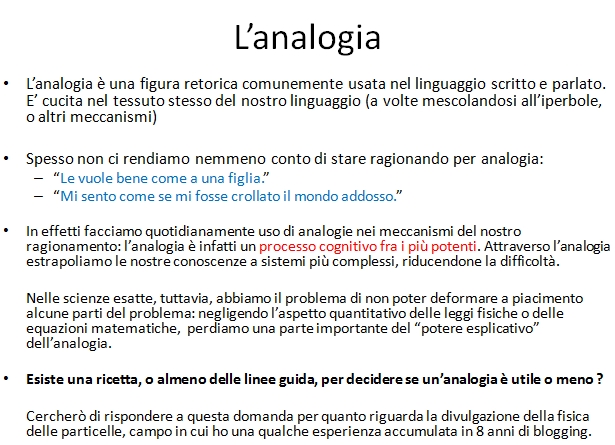
The analogy is a rhetoric figure commonly used in written and oral language. It is sewn in the very fabric of our language, sometimes mixed with hyperbole or other mechanisms. We often do not even realize we are reasoning by analogy, e.g. "He loves her like a daughter", or "I feel like I was involved in a plane crash".
As a matter of fact, we daily use analogies in our reasoning: the analogy is in fact one of the most powerful cognitive processes. By analogy we extrapolate our knowledge to more complex systems, reducing their difficulty. In science, however, we sometimes have the problem that we cannot stretch and mold as we please our problems: by neglecting the quantitative nature of physical laws or mathematical equations, for instance, we lose an important part of the explicative power of an analogy.
Hence the question: is there a recipe, or can at least some guidelines be assembled, to decide if an analogy is useful or less so ? Can one construct a "checklist", in other words, to improve the construction of analogies ? I try to answer this question for what regards the popularization of particle physics, a field where I have some experience through eight years of blogging.
The Blog and the feedback
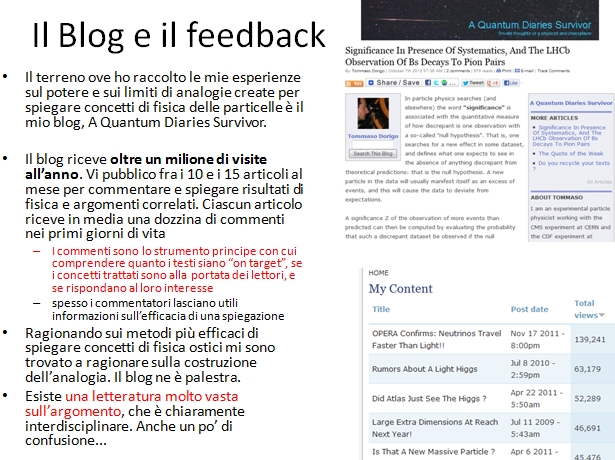
The ground where I collected my experiences on power and limits of analogies created to explain concepts in particle physics is my blog. The blog has more than a million yearly visits. I publish there 10-15 articles per month, to comment and explan physics results and related topics. Every article receives a dozen comments or so in the first days after its airing.
Comments are the main instrument with which to understand whether texts are "on target", whether the topics discussed are at reach of readers, and if they suit to their interests. Often commenters leave useful information on the effectiveness of my explanations.
Reasoning on the most effective methods useful to explain complicated physics concepts I found myself pondering on the construction of good analogies. The blog is the testing ground for this.
One must note that there exists a quite vast literature on the clearly inter-disciplinary topic.
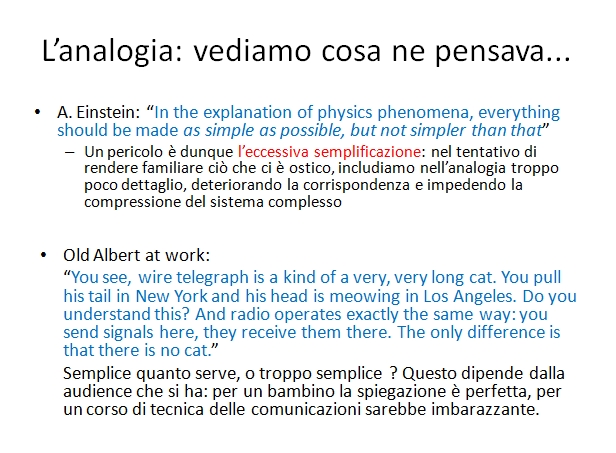
A. Einstein wrote that in the explanation of physics phenomena, everything should be made as simple as possible, but not simpler. A danger is therefore the excessive simplification: in the attempt to make familiar what is hard to grasp, we include in the analogy too little detail, worsening the correspondence between source and target, and preventing the comprehension of the complex system.
Old Albert at work: "You see, wire telegraph is a kind of a very, very long cat. You pull his tail in New York and his head is meowing in LA. Do you understand this ? And radio operates exactly the same way: you send signals here, they receive them there. The only difference is that there is no cat."
Is this simple enough, or too simple ? This depends on the audience: for a child the explanation is perfect, while for a course in telecommunications it would sound awkward.
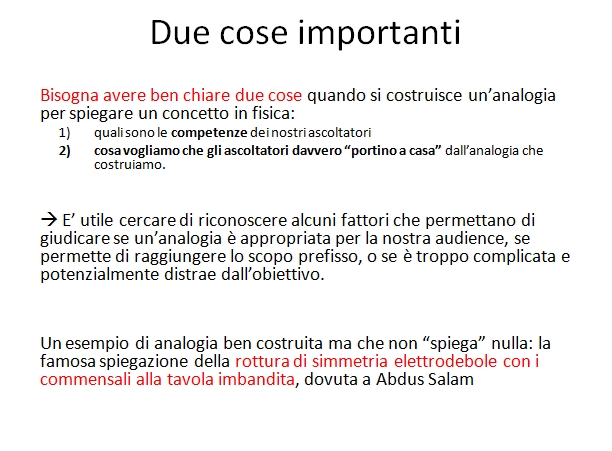
One can mention two important question to ask ourselves when constructing an analogy to explain a physics concept: what are the competences of our listeners ? And what do we want them to "bring home" from the analogy we build ?
It is useful to try and recognize some factors that allow us to judge whether an analogy is appropriate for our audience, if it delivers as planned, or if it is too complicated and distracting.
An example of a well-built analogy which however explains nothing: the famous explanation of electroweak symmetry breaking with the dinner table, due to Abdus Salam.
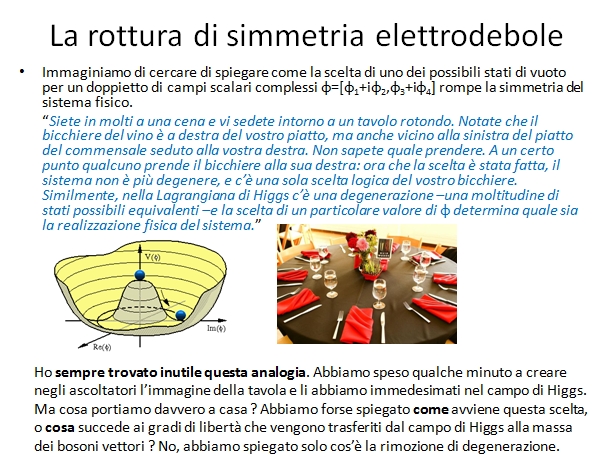
Imagine you try to explain how the choice of one of the possible vacua of a doublet of scalar fields breaks the symmetry of the physical system:
"You are at dinner and you sit around a round table. You notice that the wine glass is on the right of your plate, but also on the left of the plate of the person sitting on your right. You do not know whether you should pick that glass or the one to your left. At some point somebody takes the glass to his right: now that the choice is made, the system does not have a degeneracy, and there's only one logical choice for your glass. Similarly, in the Higgs Lagrangian there is a degeneracy -a multitude of possible equivalent states- and the choice of one of them determines what is the physical realization of the system".
I always found this analogy useless. We spent time to create in our listeners the image of the dinner table, and we asked them to take the part of the Higgs field. But what do we really bring home ? Did we ask how the choice occurs, or what happens to the degrees of freedom transferred from the Higgs field to the vector boson masses ? No, we just explained that a choice removes a degeneracy. Thanks a lot !
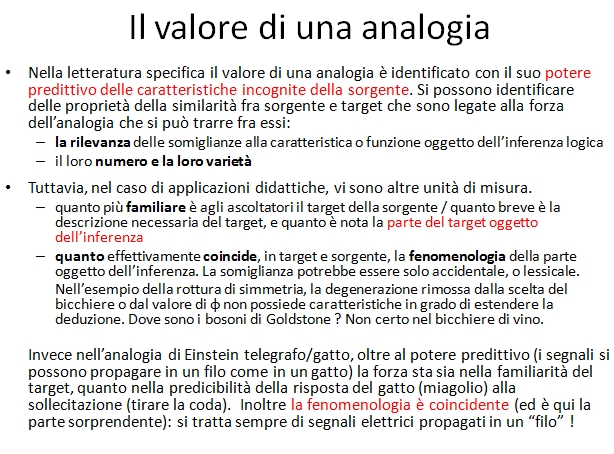
In the literature devoted to the topic the value of an analogy is identified with its predictive power of the unknown characteristics of the source. One may identify properties of the similarity between source and target, which are connected to the strength of the analogy one can draw between them: the relevance of the similarities to the characteristic or function which is the ultimate goal of our logical inference, and their number and variety.
However, in the case of didatical applications, there are other measurement units: how more familiar is to the listeners the target than the source, or how concise can the description of the target be made; and how well known is the part of the target which is the object of the inference.
Also, one must ask oneself how closely matches, in target and sources, the phenomenology of the part of the system which is the focus of the inference. The similarity could be just accidental, or lexical. In the example of the breaking of electroweak symmetry, the removed degeneracy does not possess characteristics capable of extending the deduction. Where are the Goldstone bosons ? Certainly not in the glass of wine.
Instead, in Einstein's telegraph/cat case, besides the predicted power (signals can propagate in a wire as they do in a cat) the strength is both in the familiarity of the target, and in the predictability of the cat response to the stimulus. Further, the phenomenology is coincident (and here lays the surprising part): despite the difference of the two systems, it is always of electrical signals propagating in a wire that we are talking !
Typical problems
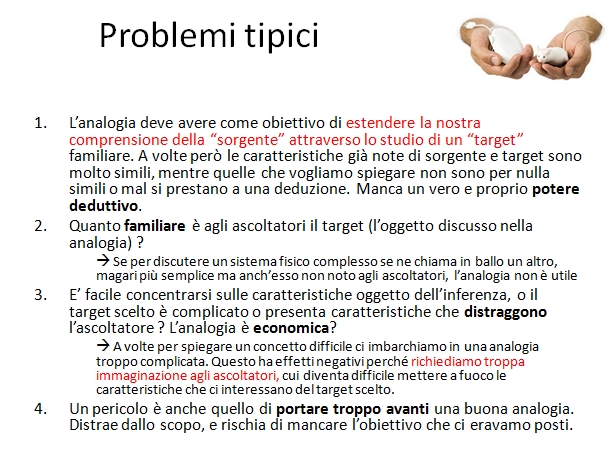
The analogy must have as objective the extension of our understanding of the source through the study of a target which is already known. Sometimes, however, the already known characteristics of source and target are very similar, while those we wish to explain are by no means similar or hardly lend themselves to a deduction. There is a lack of deductive power.
How familiar is to the listeners the target ? If, to discuss a complex physical system, we call in question another maybe simpler but still unknown to the listeners, the analogy fails to be useful. A classic example is the explanation of hidden electroweak symmetry with a ferromagnet: if the listeners are unfamiliar with the complex of magnetic domains and alignment of spins, the analogy is to be avoided.
Is it easy to concentrate on the characteristics object of the inference, or is the chosen target complex or distracting to the listener ? Is the analogy an economical one ? Sometimes to explain a difficult concept we use a too complex analogy. This has negative effects because we require too much imagination to our listeners. They find it hard to focus on the characteristics which matter in the chosen target.
A danger is also the one of bringing the analogy too far. It may distract from the goal, risking to jeopardize it.
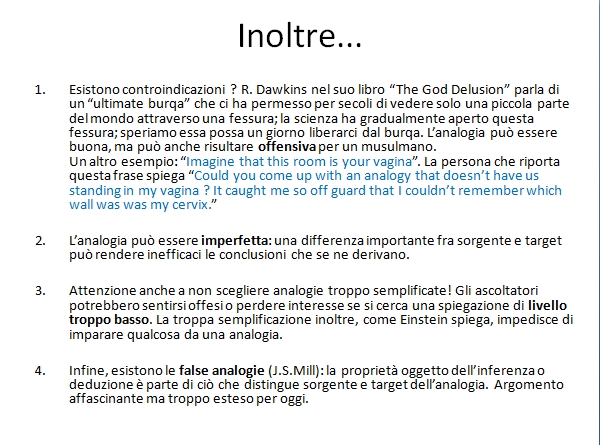
Furthermore, there can be drawbacks. Richard Dawkins in "The God Delusion" speaks of a "ultimate burqa" which allowed us for centuries to see only a small part of the world through a thin slit. Science gradually opened that slit, and we hope that one day it can free us from the burqa altogether. The analogy may be good, but it can also result an offensive one for a muslim.
Another example: "Imagine that this room is your vagina". The person reporting this sentence explains: "Could you come up with an analogy that doesn't have us standing in my vagina ? It caught me so off-guard that I couldn't remember which wall was my cervix."
The analogy can also be imperfect: an important difference between source and target may render ineffective the conclusions that can be drawn.
Care must be used to avoid analogies too simplified. Listeners might feel offended or lose interest if one uses analogies of too low level. The oversimplification, besides, prevents us to learn something from an analogy, as noted by Einstein and discussed above.
Finally, there exist false analogies (J.S.Mill studied them carefully). The properties object of the inference or deduction are part of what really distinguishes source and target of the analogy. A fascinating topic, but clearly off today's agenda.
Some examples from the blog
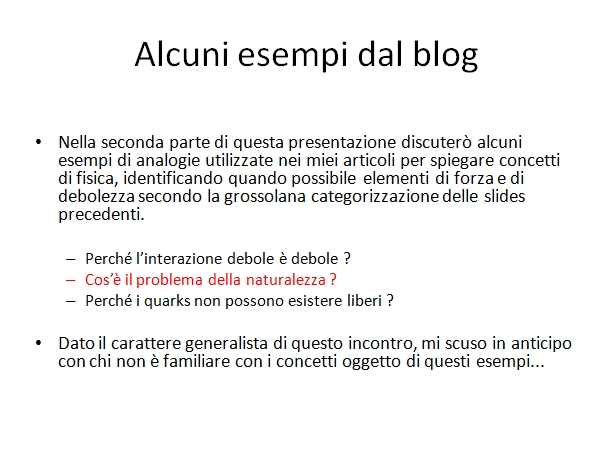
In the second part of this presentation I will discuss some examples of analogies which I used in my articles to explain physics concepts, identifying in turn the elements of strength and weakness according to the rough categorization I attempted above.
- Why are weak interactions weak ?
- What is the naturalness problem ?
- Why quarks do not exist as free bodies ?
Weak interaction and the chocolate smell
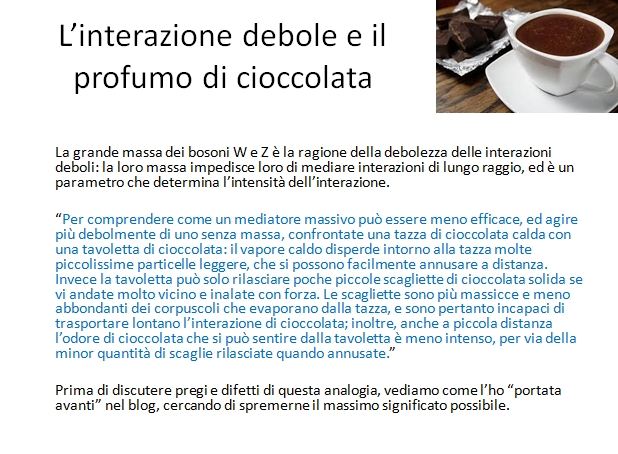
The large mass of W and Z bosons is the reason of the weakness of weak interactions: their mass prevents them from carrying long-range interactions, and is a parameter which determines the intensity of the interaction.
"To understand how a massive mediator can be less effective, and act more weakly than a massive one, compare a cup of hot chocolate with a chocolate bar: the hot vapour carries away many very small light-weight particles, which can be easily smelt from a distance. On the other hand, the bar can only release few small specks of solid chocolate if you go quite near it and inhale powerfully. The specks are much more massive and less abundant than the corpuscles evaporating from the cup, and are thus incapable to carry far away the chocolate interaction; furthermore, even at small distance the odour of chocolate that can be smelt from the bar is less intense, because of the smaller number of specks released."
Before I discuss strong and weak points of this analogy, let me show you how I "carried it further" in the blog, attempting to squeeze the maximum possible meaning from the setup.
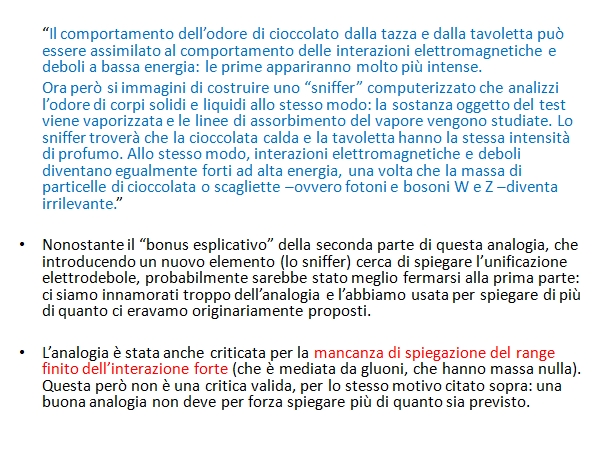
"The behaviour of the smell of chocolate from the cup and from the bar can be likened to the behaviour of electromagnetic and weak interactions at low energy: the first will appear much more intense. Now, however, let us imagine we construct a sort of computerized sniffer, which can analyze the odour of bodies solid and liquid alike: the substance object of the test is vaporized and the absorption lines of the vapour are studied. The sniffer will find that hot chocolate and bar have the same intensity of smell. Similarly, electromagnetic and weak interactions become equally strong at high energy, once the mass of chocolate molecules or specks -or photons and W and Z bosons- becomes irrelevant".
Despite the "explicative bonus" of the second part of this analogy, which by introducing a new element (the sniffer) attempts to explain the unification of electroweak interactions, it would probably be better to stop at the first part: we got enamoured to the analogy and used it to explain more than what we had originally intended.
The analogy above was also criticized for the lack of an explanation of the finite range of strong interactions (mediated by gluons, which are massless). This is however not a valid criticism, for the same reason cited above: a good analogy must not by force explain more than what it is designed to explain.
Evaluation of the chocolate analogy
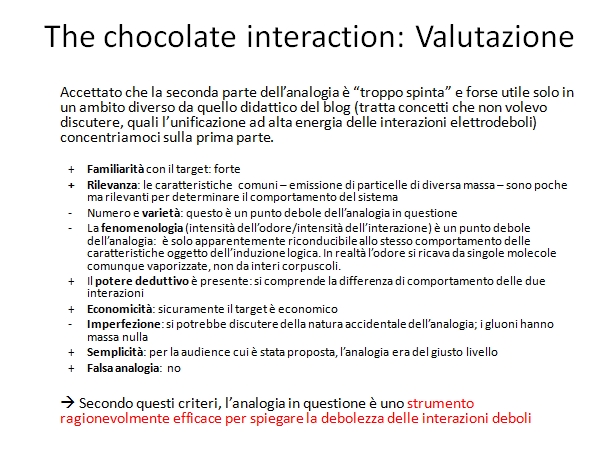
Once agreed that the second part of the analogy is pushed too far, and maybe useful only in a different context from that of the blog (it deals with concepts that I did not want to discuss, such as the unification at high energy of electroweak interactions), let us concentrate on the first part.
+ Strong familiarity with the target
+ The common characteristics are few but relevant to determine the behaviour of the system
- number and variety of similarities are small, and this is a weak point of the analogy
- the phenomenology (intensity of the odour / intensity of the interaction) is a weak spot of the analogy: it is only apparently connected to the same behaviour of the characteristics object of the logical induction.
+ the deductive power is present: one can easily understand the different behaviour of electromagnetic and weak interactions.
+ surely the target is economic.
- imperfection: one might discuss of the accidental nature of the analogy: gluons have null mass but strong interactions have a finite range too
+ simplicity: the analogy is of the right level for the audience to which it was offered.
+ false analogy ? no.
According to these criteria, we might conclude that the studied analogy is a reasonably effective tool to explain the weakness of weak interactions.
Naturalness and Mangano's 10 friends
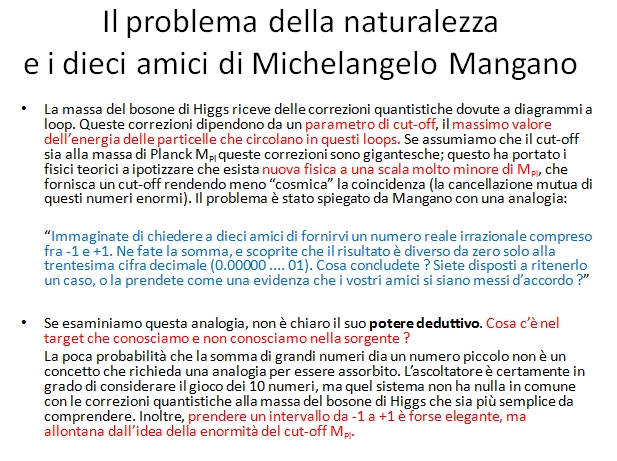
The mass of the Higgs boson receives quantum corrections due to loop diagrams. These corrections depend on a cut-off parameter, measuring the maximum value of the momentum of particles that circulate in the loops. If we assume that the cut-off be at the Planck mass M_Pl, these corrections are huge; this brought theorists to hypothesize that there exists new physics at a scale much lower than M_Pl, in order to provide an effective "cut-off" and making less "cosmic" the coincidence (the mutual cancelation of these enormous numbers). The problem was explained by Michelangelo Mangano with an analogy:
"Imagine you ask ten friends to provide a irrational real number between -1 and +1. You add the ten numbers and discover that the result is different from zero only by the thirtysecond decimal place. What do you conclude ? Are you willing to consider it happened by chance, or do you take it as evidence that your friends conspired somehow ?"
If we examine this analogy, we see that its deductive power is not clear. What is there in the target that we know, and do not in the source ? The small probability that the sum of large numbers results in a small number is not a concept requiring an analogy to be absorbed. The listener is certainly capable of considering the game of 10 numbers, but that system has nothing in common with quantum corrections to the mass of the Higgs boson which is simpler to understand there. Furthermore, taking an interval from -1 to +1 is maybe elegant, but brings us farther from the idea of the enormity of the cut-off at M_Pl.
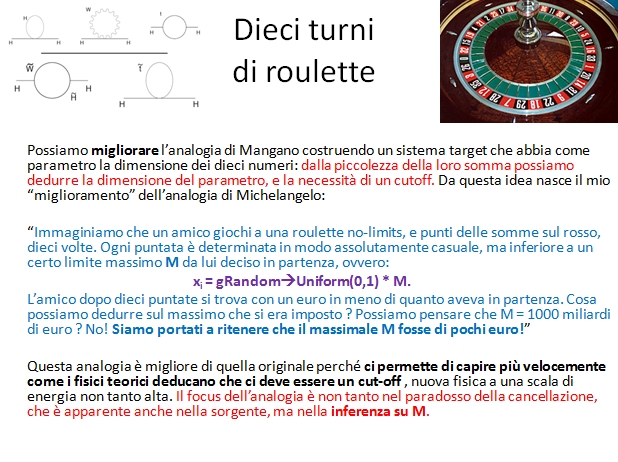
We can improve Michelangelo's analogy by constructing a target system which has as explicit parameter the dimension of the ten numbers: from the smallness of their sum we can deduce the dimension of the parameter, and the necessity of a small cut-off. From this idea is born my "improvement" to Michelangelo's analogy:
"Imagine a friend plays no-limits roulette, and places bets on red, ten times. Each sum is determined at random, but it is always inferior to a certain maximum value M decided beforehand. Our friend after ten rounds has one dollar in his pocket less than what he started with. What can we deduce on the maximum M ? Is it normal to think that M is billions of dollars ? No, we are led to believe that M was of a few euros!"
This analogy is better than the original one because it allows us to understand more quickly how theorists are led to believe that there must be a cut-off, new physics at a energy scale not too much above the TeV. The focus of the analogy is not so much in the paradox of large numbers canceling each other -something which is evident also in the source- but in the inference one may draw on M.
Evaluation of the naturalness analogy
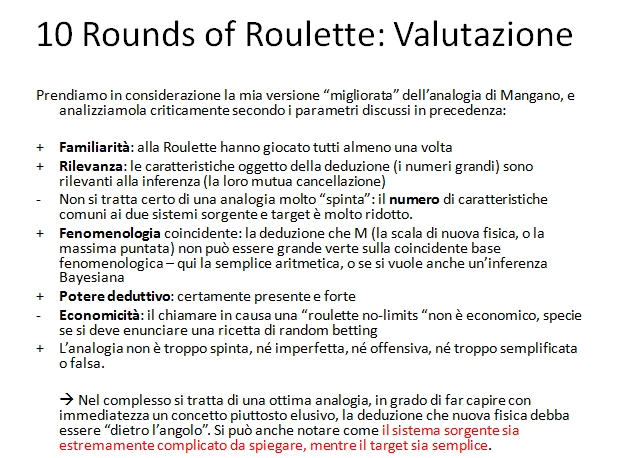
Let us consider the improved version of the naturalness analogy and let us analyze it critically according to the parameters we discussed above.
+ familiarity: we all played roulette once in our life!
+ relevance: the characteristics object of the deduction (large numbers) are relevant to the inference (their mutual cancellation).
- it is not a very strong analogy from the point of view of the number of common characteristics of target and source.
+ the phenomenology is coincident: the deduction that M cannot be large rests on the coincident phenomenological basis in source and target: simple arithmetics.
+ the deductive power is present and strong.
- the analogy is not too economical: we need to discuss a "no limits" roulette and a recipe to determine the random bets.
+ the analogy does not go too far, it is not imperfect or offensive or too simplified, nor false.
In summary this is an excellent analogy, capable of immediately explain a concept rather tough: the deduction that new physics must be "behind the corner". One may also note that the source is very complex to explain, while the target is simple.
QCD, strings, and springs
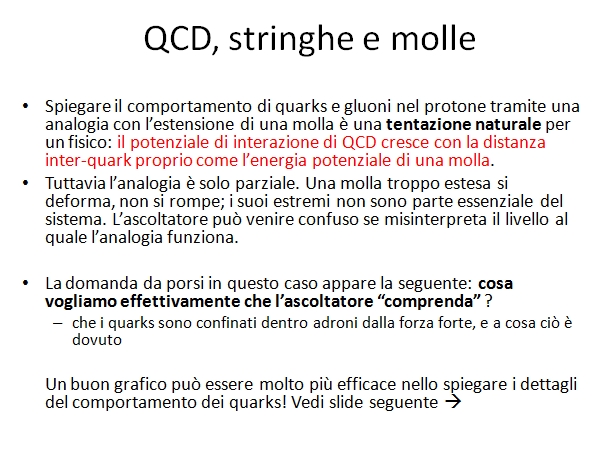
Explaining the behaviour of quarks and gluons in the proton by analogy with the extension of a spring is a natural temptation for a physicist: the potential grows linearly with the distance in both systems. However, the analogy is imperfect. A spring if overextended gets deformed instead of breaking up; its extrema are not an essential part of the system. The listener can get confused if she misinterprets the level at which the analogy works.
The question to ask ourselves in this case is the following: what do we really want our audience to understand ? The answer is: that quarks are confined inside hadrons by strong interactions, and why that is so.
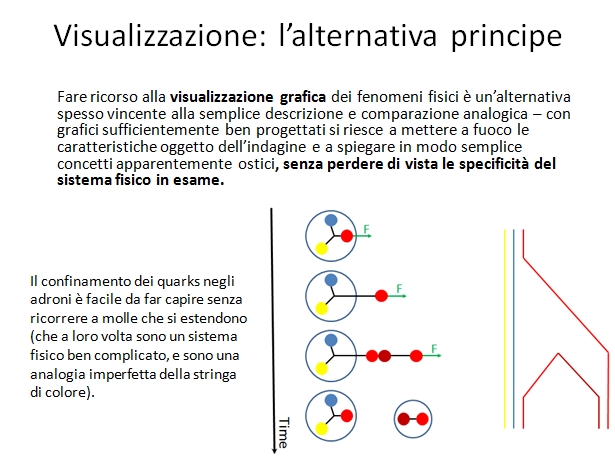
A good drawing may be much more effective in explaining the details of the behaviour of quarks. A graphical visualization of physical phenomena is a winning alternative to analogic reasoning in some cases. We focus on the characteristics of the system under study, explaining apparently complex phenomena, without losing track of the specific features of the system. Quark confinement inside hadrons is easy to explain without extending springs.
Conclusions
Analogy is a unavoidable instrument to explain physics, and it is more useful when the need of a simplification is stronger. However, it is not the only one! One must understand its strong and weak points. There are pitfalls to be avoided when constructing effective analogies. One may construct some guidelines to help in the construction of analogies that can really explain hard physics concepts. I described a few of them above.
If you build analogies in your didactical activity, ask yourself the question and operate a self-evaluation such as the one I attempted above: it is a very useful exercise. Without it, I would not have improved the 10-number analogy.
The experience of science outreach in a blog allows to test on the field and with valid feedback the value of simplified explanations of physical phenomena.




Comments